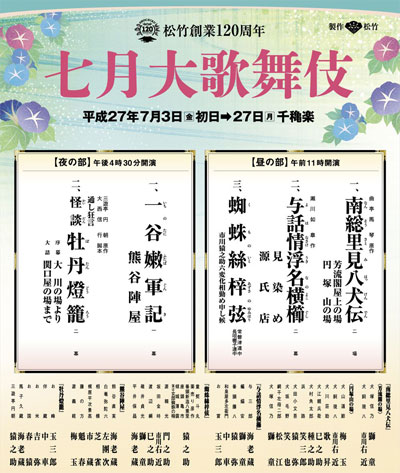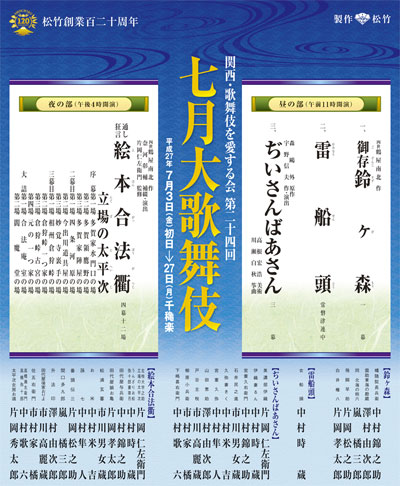| JULY 2015 |
|
5 shows in T˘ky˘ (Kabukiza, National Theatre, Shinbashi Enbuj˘, Nikkei Hall), 2 in ďsaka (Sh˘chikuza) and 2 tours (Eastern Provinces, Central Provinces)!
|
| Kabukiza (T˘ky˘) |  |
| Dates | 3 ~ 27 July 2015 (Shichigatsu ďkabuki) July Grand Kabuki |
| MatinÚe |
Yowa Nasake Ukina no Yokogushi (Kirare Yosa)
|
| Evening | |
| Casting |
Living National Treasure Band˘ Tamasabur˘, Ichikawa Ebiz˘, Ichikawa Ennosuke, Nakamura Baigyoku, Nakamura Shibajaku, Nakamura Kaishun, Ichikawa Sadanji, Kataoka Ichiz˘, Ichikawa Chűsha, Ichikawa Monnosuke, Ichikawa Ukon, Nakamura Shid˘, Kamimura Kichiya, Nakamura Matsue, Ichikawa Emiya, Ichikawa Emisabur˘, Ichikawa En'ya, Ichikawa Shun'en, Nakamura Kash˘, Band˘ Minosuke, Nakamura Tanenosuke |
| Comments |
July Grand Kabuki with Living National Treasure Band˘ Tamasabur˘, Ichikawa Ebiz˘ and Ichikawa Ennosuke as leading stars!
|
 |
| Sh˘chikuza (ďsaka) |
| Dates | 3 ~ 27 July 2015 (Kansai Kabuki o Ai Suru Kai Shichigatsu ďkabuki) The 24th Kansai Kabuki Lovers Society July Grand Kabuki |
| MatinÚe | |
| Evening | |
| Casting |
Kataoka Nizaemon, Nakamura Tokiz˘, Kataoka Takatar˘, Nakamura Kinnosuke, Nakamura Karoku, Kataoka Hidetar˘, Ichikawa Komaz˘, Ichimura Kakitsu, Ichikawa Omez˘, Sawamura Yoshijir˘, Arashi Kitsusabur˘, Kataoka Matsunosuke, Nakamura Yonekichi, Nakamura Hayato |
| Comments |
24th edition of the Kansai Kabuki Lovers Society July Grand Kabuki in ďsaka.
|
 |
| National Theatre (T˘ky˘) |
| Dates | 3 ~ 24 July 2015 (Shichigatsu Kabuki Kansh˘ Ky˘shitsu) July Kabuki Appreciation Class |
| Program |
|
| Casting |
Onoe Kikunosuke, Ichikawa Danz˘, Nakamura Baishi, Band˘ Kamesabur˘, Nakamura Mantar˘, Onoe Ukon |
| Comments |
Educational program at the National Theatre called Kabuki Kansh˘ Ky˘shitu ("Kabuki Appreciation Class"). This is a very interesting formula for the beginners because there is lively presentation of Kabuki (or some aspects of the art like music, stage tricks or fighting scenes) on stage, followed by the "Tokaiya" and "Daimotsu no Ura" scenes of the classic "Yoshitsune Senbon Zakura".
|
| Shinbashi Enbuj˘ (T˘ky˘) |
| Dates | 5 ~ 27 July 2015 (Kabuki NEXT) Kabuki NEXT |
| Program |
Aterui |
| Casting |
Ichikawa Somegor˘, Nakamura Kankur˘, Nakamura Shichinosuke, Band˘ Yajűr˘, Kataoka Kamez˘, Ichimura Manjir˘, Sawamura S˘nosuke, ďtani Hirotar˘, Band˘ Shingo, Nakamura Tsurumatsu, Ichimura Kitsutar˘ |
| Comments |
A brand new genre was born in the Kabuki world! After Kabuki, Shinkabuki, SűpÔ Kabuki, SűpÔ Kabuki II and Roppongi Kabuki (Sci-Fi Kabuki), here comes alive Kabuki NEXT. The first Kabuki NEXT drama is "Aterui", which was written by Nakajima Kazuki for Ichikawa Somegor˘. It was staged for the first time in August 2002 at the Shinbashi Enbuj˘, starring Ichikawa Somegor˘ with a non-Kabuki cast. In 2002, it was not a Kabuki or a Kabuki NEXT production. In 2015, it is revised to become the first Kabuki NEXT drama in Kabuki history, with a full Kabuki cast. The story is about the Emishi warrior Aterui (Ichikawa Somegor˘), who is fighting for the independence of the Emishi people against the Japanese army led by the general Sakanoue no Tamuramaro (Nakamura Kankur˘). The third character of "Aterui" is the Emishi beautiful woman Tate Eboshi (Nakamura Shichinosuke).
|
| Kabuki Tour in the central provinces | |
| Dates | 30 June ~ 31 July 2015 (Sh˘chiku ďkabuki) Sh˘chiku Grand Kabuki |
| Program | |
| Casting |
Nakamura Hashinosuke, ďtani Tomoemon, Matsumoto Kingo, Band˘ Shűch˘, Nakamura Kotar˘, Nakamura Kunio, Nakamura Shinobu, Nakamura Hashigo, Nakamura Shikimatsu |
| Comments |
The usual July Grand Kabuki Tour in the central provinces!
|
| Kabuki Tour in the Eastern Provinces | |
| Dates | 30 June ~ 31 July 2015 (Sh˘chiku ďkabuki) Sh˘chiku Grand Kabuki |
| Program | |
| Casting |
Living National Treasure Sakata T˘jűr˘, Nakamura Ganjir˘, Nakamura Senjaku, Onoe Sh˘roku, Nakamura Kikaku, Band˘ Kametoshi, Nakamura Kazutar˘, Nakamura Toranosuke |
| Comments |
Nakamura Ganjir˘ IV celebrates his shűmei touring in the eastern provinces!
|
| Nikkei Hall (T˘ky˘) |
| Dates | 31 July 2015 (Kabuki Buy˘ K˘en) Kabuki Traditional Dances Performances |
| Program |
Hokushű |
| Casting | |
| Comments |
The 17th ďtemachiza stage performances at the Nikkei Hall in T˘ky˘.
|
|
|
| Contact | Main | Top | Updates | Actors | Plays | Playwrights | Programs | Links | FAQ | Glossary | Chronology | Illustrations | Prints | Characters | Derivatives | Theaters | Coming soon | News |